Epstein-Barr virus Virus Viruses are infectious, obligate intracellular parasites composed of a nucleic acid core surrounded by a protein capsid. Viruses can be either naked (non-enveloped) or enveloped. The classification of viruses is complex and based on many factors, including type and structure of the nucleoid and capsid, the presence of an envelope, the replication cycle, and the host range. Virology (EBV) is a linear, double-stranded DNA DNA A deoxyribonucleotide polymer that is the primary genetic material of all cells. Eukaryotic and prokaryotic organisms normally contain DNA in a double-stranded state, yet several important biological processes transiently involve single-stranded regions. DNA, which consists of a polysugar-phosphate backbone possessing projections of purines (adenine and guanine) and pyrimidines (thymine and cytosine), forms a double helix that is held together by hydrogen bonds between these purines and pyrimidines (adenine to thymine and guanine to cytosine). DNA Types and Structure virus Virus Viruses are infectious, obligate intracellular parasites composed of a nucleic acid core surrounded by a protein capsid. Viruses can be either naked (non-enveloped) or enveloped. The classification of viruses is complex and based on many factors, including type and structure of the nucleoid and capsid, the presence of an envelope, the replication cycle, and the host range. Virology belonging to the Herpesviridae Herpesviridae A family of enveloped, linear, double-stranded DNA viruses infecting a wide variety of animals. Subfamilies, based on biological characteristics, include: alphaherpesvirinae; betaherpesvirinae; and gammaherpesvirinae. Herpes Simplex Virus 1 and 2 family. This highly prevalent virus Virus Viruses are infectious, obligate intracellular parasites composed of a nucleic acid core surrounded by a protein capsid. Viruses can be either naked (non-enveloped) or enveloped. The classification of viruses is complex and based on many factors, including type and structure of the nucleoid and capsid, the presence of an envelope, the replication cycle, and the host range. Virology is mostly transmitted through contact with oropharyngeal secretions from an infected individual. The virus Virus Viruses are infectious, obligate intracellular parasites composed of a nucleic acid core surrounded by a protein capsid. Viruses can be either naked (non-enveloped) or enveloped. The classification of viruses is complex and based on many factors, including type and structure of the nucleoid and capsid, the presence of an envelope, the replication cycle, and the host range. Virology can infect epithelial cells and B lymphocytes B lymphocytes Lymphoid cells concerned with humoral immunity. They are short-lived cells resembling bursa-derived lymphocytes of birds in their production of immunoglobulin upon appropriate stimulation. B cells: Types and Functions, where it can undergo lytic replication or latency. The initial infection can present as infectious mononucleosis Mononucleosis Infectious mononucleosis (IM), also known as "the kissing disease," is a highly contagious viral infection caused by the Epstein-Barr virus. Its common name is derived from its main method of transmission: the spread of infected saliva via kissing. Clinical manifestations of IM include fever, tonsillar pharyngitis, and lymphadenopathy. Mononucleosis, and reactivation Reactivation Herpes Simplex Virus 1 and 2 (often in patients Patients Individuals participating in the health care system for the purpose of receiving therapeutic, diagnostic, or preventive procedures. Clinician–Patient Relationship who are HIV HIV Anti-HIV Drugs positive) can cause oral hairy leukoplakia Leukoplakia Leukoplakia is a potentially malignant lesion affecting the squamous epithelium usually within the oral cavity. Leukoplakia can be associated with a history of chronic tobacco and alcohol use, both of which can synergistically damage the epithelium. Leukoplakia. An important feature of EBV infections Infections Invasion of the host organism by microorganisms or their toxins or by parasites that can cause pathological conditions or diseases. Chronic Granulomatous Disease is the ability to transform B cells B cells Lymphoid cells concerned with humoral immunity. They are short-lived cells resembling bursa-derived lymphocytes of birds in their production of immunoglobulin upon appropriate stimulation. B cells: Types and Functions, which provides immortalization and proliferation. Thus, EBV is associated with lymphoproliferative disorders Lymphoproliferative disorders Disorders characterized by proliferation of lymphoid tissue, general or unspecified. Lymphocytosis and malignancies, such as Burkitt lymphoma Lymphoma A general term for various neoplastic diseases of the lymphoid tissue. Imaging of the Mediastinum, Hodgkin lymphoma Lymphoma A general term for various neoplastic diseases of the lymphoid tissue. Imaging of the Mediastinum, hemophagocytic lymphohistiocytosis, post-transplant lymphoproliferative disease, certain gastric cancers, and nasopharyngeal carcinoma.
Last updated: Sep 8, 2022
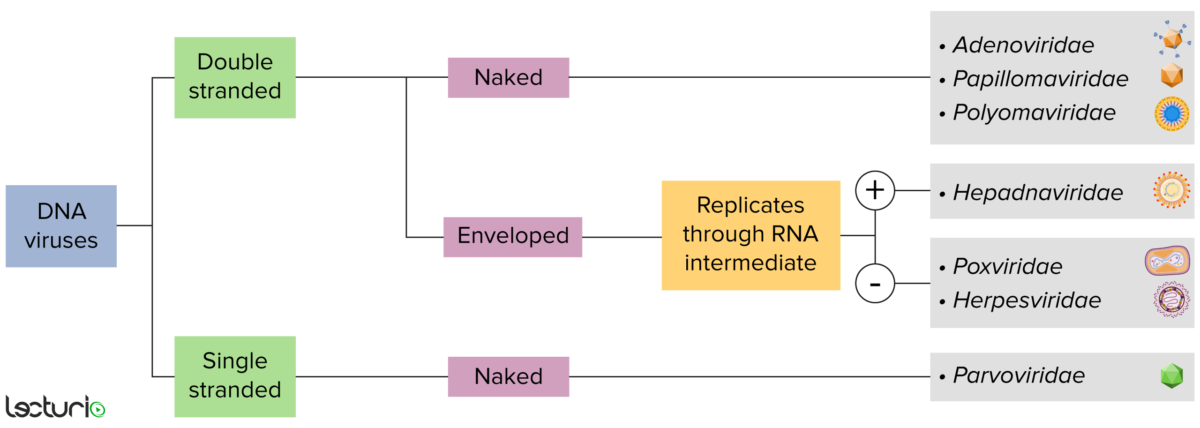
Identification of DNA viruses:
Viruses can be classified in many ways. Most viruses, however, will have a genome formed by either DNA or RNA. Viruses with a DNA genome can be further characterized as single or double stranded. “Enveloped” viruses are covered by a thin coat of cell membrane, which is usually taken from the host cell. If the coat is absent, however, the viruses are called “naked” viruses. Some enveloped viruses translate DNA into RNA before incorporating into the genome of the host cell.
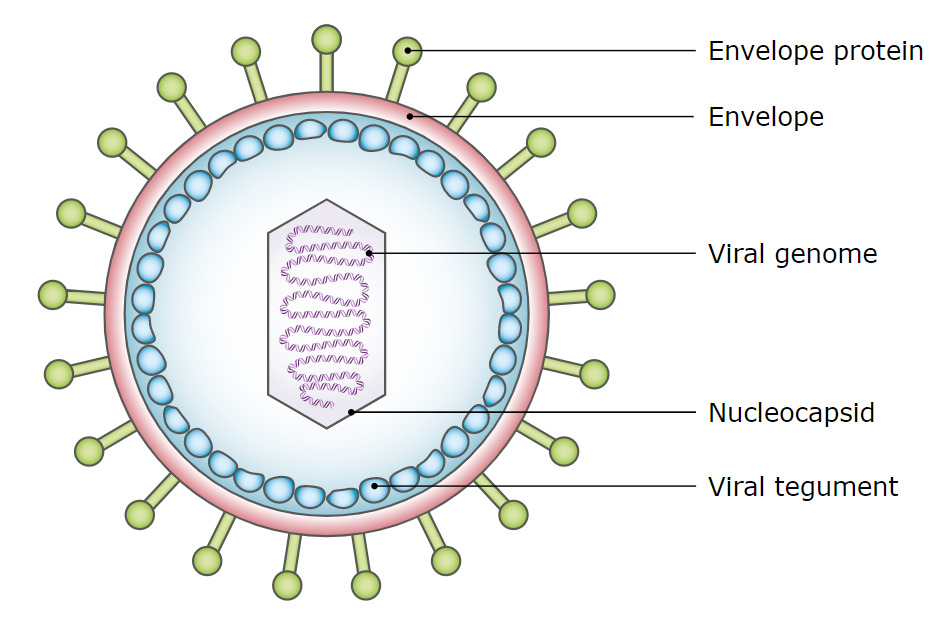
Simplified diagram of the structure of the Epstein-Barr virus
Image: “Simplified diagram of the structure of EBV” by Ben Taylor. License: Public Domain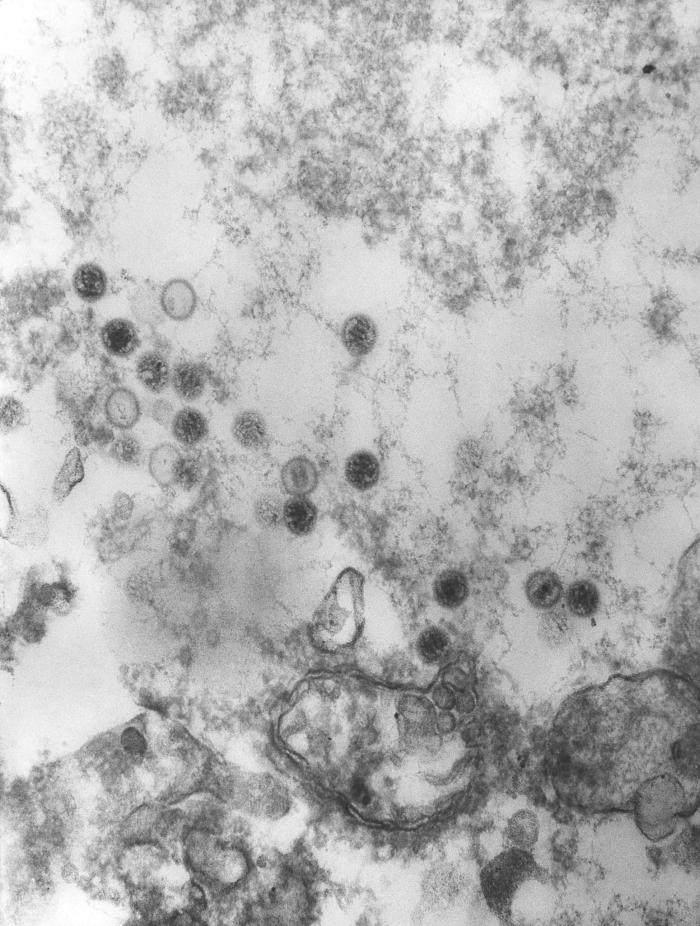
Transmission electron microscopic image showing the presence of numerous Epstein-Barr virus (EBV) virions, members of the Herpesviridae virus family:
At the core of its proteinaceous capsid, EBV contains a double-stranded DNA linear genome.
Humans are the only reservoir Reservoir Animate or inanimate sources which normally harbor disease-causing organisms and thus serve as potential sources of disease outbreaks. Reservoirs are distinguished from vectors (disease vectors) and carriers, which are agents of disease transmission rather than continuing sources of potential disease outbreaks. Humans may serve both as disease reservoirs and carriers. Escherichia coli.
Cell entry:
Latency:
Lytic replication:
Cell types infected:
Primary infection Primary infection Herpes Simplex Virus 1 and 2:
Lymphoproliferative disorders Lymphoproliferative disorders Disorders characterized by proliferation of lymphoid tissue, general or unspecified. Lymphocytosis:
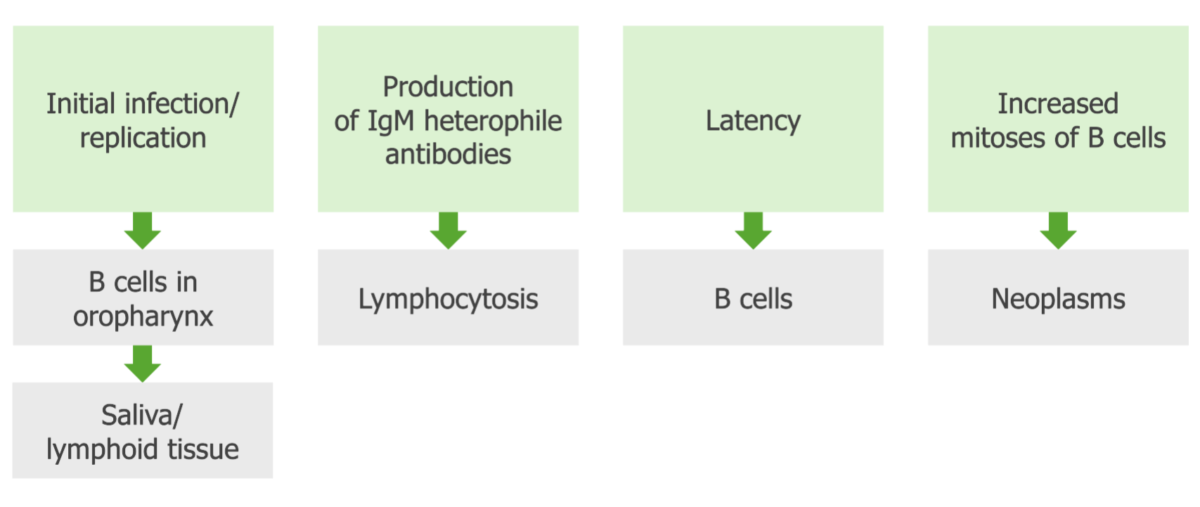
Pathogenesis of norovirus infection
Image by Lecturio. License: CC BY-NC-SA 4.0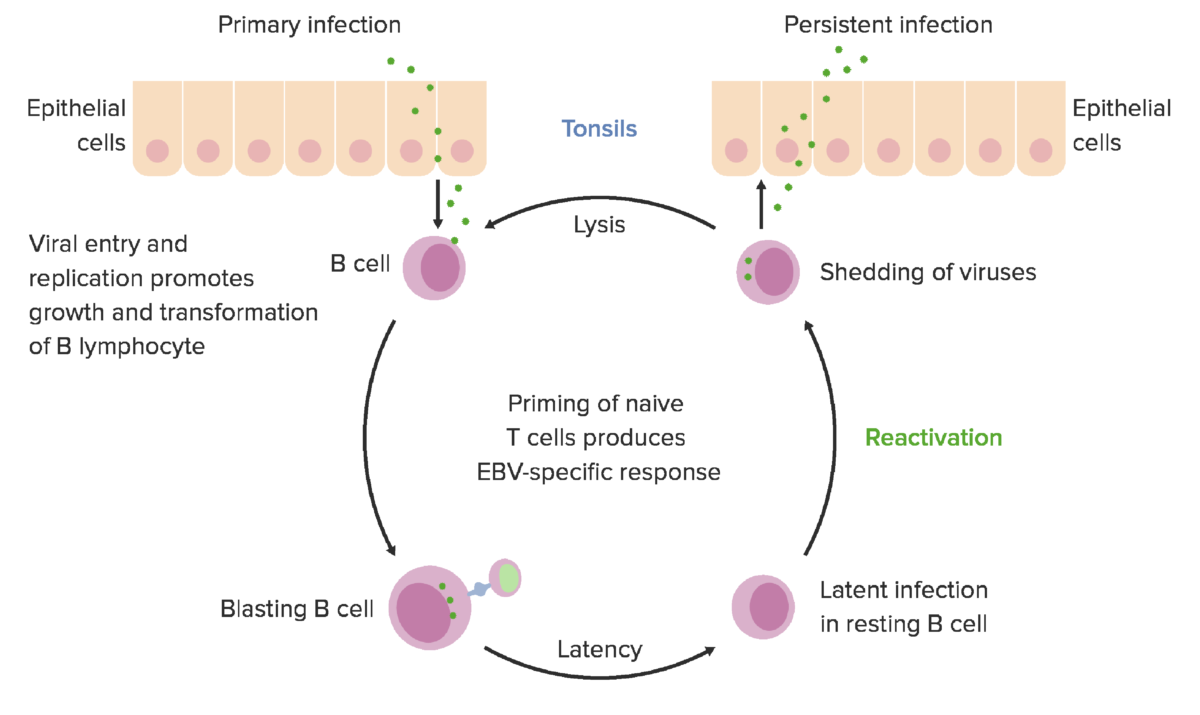
The EBV can infect both B cells and oropharyngeal epithelial cells:
The virus enters B cells by binding to the cellular receptor CD21, allowing fusion of the viral envelope with the cell membrane.
The lytic cycle results in the production of infectious virions in both B cells and oropharyngeal epithelial cells. In B cells, lytic replication normally only takes place after reactivation from latency, whereas in oropharyngeal epithelial cells, lytic replication often directly follows viral entry.
During lytic replication, viral DNA polymerase is responsible for synthesizing the viral genome. This contrasts with latency, in which host-cell DNA polymerase copies the viral genome. However, latency does not result in the production of virions, since only a portion of EBV’s genes are expressed.
Presentation:
Diagnosis:
Management:
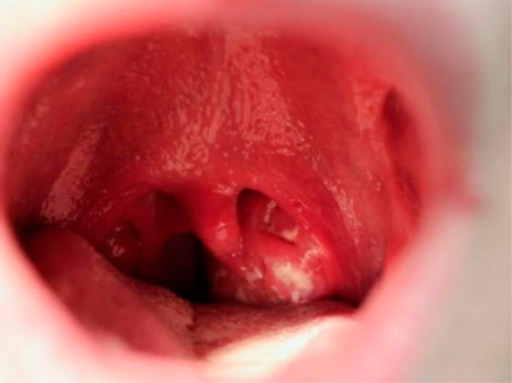
Infectious mononucleosis:
pharyngitis demonstrating exudative tonsillitis and an enlarged uvula in a 19-year-old undergraduate university student 5 days after onset of infectious mononucleosis
Oral hairy leukoplakia Leukoplakia Leukoplakia is a potentially malignant lesion affecting the squamous epithelium usually within the oral cavity. Leukoplakia can be associated with a history of chronic tobacco and alcohol use, both of which can synergistically damage the epithelium. Leukoplakia is caused by the reactivation Reactivation Herpes Simplex Virus 1 and 2 of latent EBV and occurs mostly in patients Patients Individuals participating in the health care system for the purpose of receiving therapeutic, diagnostic, or preventive procedures. Clinician–Patient Relationship who are HIV HIV Anti-HIV Drugs positive.
Clinical presentation:
Diagnosis:
Management:

White, hairy patch on a patient’s tongue due to oral hairy leukoplakia
Image: “Advanced oral hairy leukoplakia (OHL)” by CDC. License: Public Domain| Disease | Characteristics | Clinical presentation | Management |
|---|---|---|---|
| Burkitt lymphoma Lymphoma A general term for various neoplastic diseases of the lymphoid tissue. Imaging of the Mediastinum |
|
|
|
| Hodgkin lymphoma Lymphoma A general term for various neoplastic diseases of the lymphoid tissue. Imaging of the Mediastinum | Reed-Sternberg cells Reed-Sternberg cells Large cells, usually multinucleate, whose presence is a common histologic characteristic of classical hodgkin disease. Hodgkin Lymphoma |
|
|
| Hemophagocytic lymphohistiocytosis |
|
|
|
| Post-transplant lymphoproliferative disease |
|
|
↓ Immunosuppressive therapy |
| Nasopharyngeal carcinoma |
|
|
|
| EBV-associated gastric carcinoma |
|
|
|
There are 115 different total known species of herpesviruses that are grouped into 3 families:
| HHV | Common name | Primary target cells | Latency site | Clinical presentation* |
|---|---|---|---|---|
|
1 (alpha group) |
HSV-1 | Mucoepithelial cells | Dorsal root ganglia |
|
|
2 (alpha group) |
HSV-2 |
|
||
|
3 (alpha group) |
VZV |
|
||
|
4 (gamma group) |
EBV |
|
Memory Memory Complex mental function having four distinct phases: (1) memorizing or learning, (2) retention, (3) recall, and (4) recognition. Clinically, it is usually subdivided into immediate, recent, and remote memory. Psychiatric Assessment B cells B cells Lymphoid cells concerned with humoral immunity. They are short-lived cells resembling bursa-derived lymphocytes of birds in their production of immunoglobulin upon appropriate stimulation. B cells: Types and Functions |
|
|
5 (beta group) |
CMV |
|
Hematopoietic progenitor cells in bone marrow Bone marrow The soft tissue filling the cavities of bones. Bone marrow exists in two types, yellow and red. Yellow marrow is found in the large cavities of large bones and consists mostly of fat cells and a few primitive blood cells. Red marrow is a hematopoietic tissue and is the site of production of erythrocytes and granular leukocytes. Bone marrow is made up of a framework of connective tissue containing branching fibers with the frame being filled with marrow cells. Bone Marrow: Composition and Hematopoiesis |
|
|
6A, 6B (beta group) |
HHV-6 HHV-6 Human herpesvirus (HHV)-6 and HHV-7 are similar double-stranded DNA viruses belonging to the Herpesviridae family. Human herpesviruses are ubiquitous and infections are commonly contracted during childhood. Human Herpesvirus 6 and 7 | T cells T cells Lymphocytes responsible for cell-mediated immunity. Two types have been identified – cytotoxic (t-lymphocytes, cytotoxic) and helper T-lymphocytes (t-lymphocytes, helper-inducer). They are formed when lymphocytes circulate through the thymus gland and differentiate to thymocytes. When exposed to an antigen, they divide rapidly and produce large numbers of new T cells sensitized to that antigen. T cells: Types and Functions | Monocytes Monocytes Large, phagocytic mononuclear leukocytes produced in the vertebrate bone marrow and released into the blood; contain a large, oval or somewhat indented nucleus surrounded by voluminous cytoplasm and numerous organelles. Innate Immunity: Phagocytes and Antigen Presentation | Roseola |
|
7 (beta group) |
HHV-7 HHV-7 Human herpesvirus (HHV)-6 and HHV-7 are similar double-stranded DNA viruses belonging to the Herpesviridae family. Human herpesviruses are ubiquitous and infections are commonly contracted during childhood. Human Herpesvirus 6 and 7 | T cells T cells Lymphocytes responsible for cell-mediated immunity. Two types have been identified – cytotoxic (t-lymphocytes, cytotoxic) and helper T-lymphocytes (t-lymphocytes, helper-inducer). They are formed when lymphocytes circulate through the thymus gland and differentiate to thymocytes. When exposed to an antigen, they divide rapidly and produce large numbers of new T cells sensitized to that antigen. T cells: Types and Functions | ||
|
8 (gamma group) |
KSHV |
|
B cells B cells Lymphoid cells concerned with humoral immunity. They are short-lived cells resembling bursa-derived lymphocytes of birds in their production of immunoglobulin upon appropriate stimulation. B cells: Types and Functions | Kaposi Kaposi A multicentric, malignant neoplastic vascular proliferation characterized by the development of bluish-red cutaneous nodules, usually on the lower extremities, most often on the toes or feet, and slowly increasing in size and number and spreading to more proximal areas. The tumors have endothelium-lined channels and vascular spaces admixed with variably sized aggregates of spindle-shaped cells, and often remain confined to the skin and subcutaneous tissue, but widespread visceral involvement may occur. Hhv-8 is the suspected cause. There is also a high incidence in AIDS patients. AIDS-defining Conditions sarcoma |